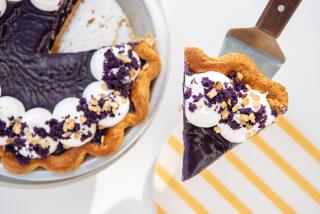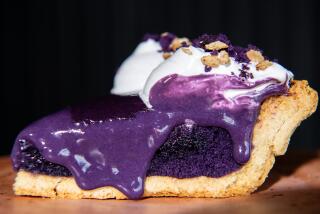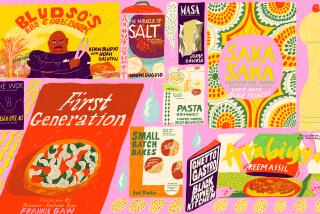Faithful to the Core, Past and Present
There are many ways to eat an apple. My centenarian grandmother likes to peel the skin first. Artfully, she guides the paring knife clockwise from top to bottom and produces a red spiral peel so beautiful you want to hang it from the ceiling like a mobile. As a child, I would play with the curly peel and then eat it.
My mother believes apples taste best when baked in pies. She uses whatever pan she can find in the kitchen, sometimes using a large cookie sheet to make a big rectangular pie that’s enough to feed an army.
I have been trying to get her recipe, but it changes every time I ask her. She relies on her eyes to measure the ingredients, and, while they may be useful to sort out the good apples from the bad ones, they are not accurate in the way a scale is. Still, I have yet to eat a bad apple pie she has baked.
When I was a girl, she always baked in the middle of the night, when everyone was asleep. Cool temperatures and peace of mind were high on her list of optimum conditions. But such peace was often disrupted when the smell of pies baking in the hot oven would rise to the bedrooms and stir the sleep of her five children. We would come down to the kitchen in our pajamas and munch on the sliced apples as my mother raced to peel more to replace them. If there was any leftover dough, she would let us make roses and leaves to decorate the tops of the pies.
Usually, we would hang out in the kitchen long enough to get a taste of the warm pie before we were sent upstairs. By dawn, the pies would be sitting on the kitchen counter, wrapped in foil, ready to be sent off with my father to work. My father never asked her for them, but every fall and winter my mother made sweet treats for his office.
I will never forget the applesauce that a pots and pans salesman once made for us. My mother was a sucker for any door-to-door salesmen who rang our doorbell. If it wasn’t the Fuller Brush man, who rang the bell and knocked persistently until my mother surrendered, it was the Encyclopedia Britannica salesman or the Avon Lady.
Then, one day, the pots and pans salesman showed up at our doorstep with his whole shop. His belly popped out and draped over his belt, which was enough to make me suspicious, but, as always, my mother quickly gave into the friendly sales pitch and invited the stranger into the house.
Before long, he worked his way into the kitchen where he wanted to show us how to make applesauce. I wasn’t sure I could trust him, but, like a magician, he produced a half-dozen apples and a shiny, heavy stainless steel pan out of his carrying bag and made himself at home.
He prepared applesauce in two pans: one in the saucepan he was trying to sell us, another in the dented aluminum pan that belonged to my mother. To our surprise, the applesauce he made in his saucepan tasted much sweeter and smoother than the one he made in my mother’s pan. He said that the tight lid, which sealed the pan and allowed the apples to steam, did the trick.
After the demonstration, my mother was convinced that a set of these pots and pans would make a nice dowry for me. When the salesman offered her an attractive layaway plan, a bonus gift of an electric crepe maker and a full warranty, she lit up like a bright bulb. He walked out of the house with the down payment on the whole set of pots and pans and a big smile. I was only 17 years old and marriage was the last thing on my mind, but there I was with pots and pans that were promised to last me a lifetime.
Recently I learned that my neighbor across the street has an apple tree in her backyard. Some of the apples are big and green like a Granny Smith; others are blushed like a McIntosh. She doesn’t know what kind of apple it produces, but she says the fruit is too tart to be eaten raw. So most of them stay on the tree until they fall and rot.
When she showed me the tree, my neighbor seemed a bit embarrassed by its imperfections and pulled me away to look instead at her beautiful roses. When I told her I wanted to have some apples, she thought I was out of my mind but handed me a shopping bag and invited me to take as many apples as I wanted.
As I brought home my bag full of irregular apples, a rusty cast-iron pan--the one the former owner of our house left behind--caught my eye. It was in the garage, waiting to be donated to the Salvation Army, but I suddenly had a brilliant idea. I wanted to make a tarte tatin.
I scrubbed the pan until it was black and shiny again. With my neighbor’s neglected apples and the castoff pan, I produced a wonderful tarte tatin on my first try. Since then, it has become my favorite homemade dessert. The only time I failed was when I walked away from the stove when the apples were caramelizing. I nearly ruined the pan, but with a little more scrubbing it survived my abuse, as cast-iron pans usually will.
By the way, 30 years later that set of pots and pans the salesman convinced my mother to buy is still holding up, more or less, here in Los Angeles and across the Pacific in Tokyo, where my grandmother treasures the bonus electric crepe maker, which she stores in its original box and takes out when she finds an occasion to make apple crepes.
*
Applesauce
Active Work Time: 20 minutes * Total Preparation Time: 45 minutes
My Italian relative makes an applesauce with a variety of apples that grow on her land. She says Golden Delicious makes the tastiest applesauce. After experimenting with various apples, I agree. Golden Delicious is low in pulp and makes a delicious smooth applesauce. Some people, however, prefer applesauce with texture, in which case you might try the pulpier Pink Lady or Roma apples.
*
6 firm apples peeled, cored and sliced into 8 wedges
3 tablespoons sugar, plus more if necessary
1/4 cup water
Combine the apples, sugar and water in a saucepan. Cover and cook over medium-low heat for about 8 minutes. Remove the lid and stir from the bottom to prevent sticking. If the apples are sticking, add 1 or 2 more tablespoons of water. Cover the saucepan and continue cooking until the apples start to fall apart, stirring once or twice to prevent sticking, another 7 to 12 minutes.
Remove from the heat and mash the apples with a fork or potato masher. Taste the sweetness of the applesauce. Add an additional teaspoon or 2 of sugar as needed. Serve warm as a side dish or chilled as a dessert with cream if you like.
*
4 cups. Each 1/2-cup serving: 68 calories; 0 sodium; 0 cholesterol; 0 fat; 0 saturated fat; 18 grams carbohydrates; 0 protein; 2.31 grams fiber.
*
Akiko Kondo’s Double-Crusted Apple Pie
Active Work Time: 45 minutes * Total Preparation Time: 2 hours plus 1 hour chilling
My mother likes the natural flavors of the apples and dislikes cinnamon--the common flavoring for American apple pies. My sister, the pastry chef, recommends vanilla to flavor the apples in a pie, which I like. Simply split a piece of vanilla bean and scrape the seeds into the sugar. Then add the flavored sugar to the apples. If vanilla bean is not available, add about 1 teaspoon of vanilla extract to the pan immediately after the apples turn transparent in cooking. The filling is not thickened. Tart apples, especially Pippin, do not produce much liquid during cooking, but if they do, simply take the semi-cooked apples out of the pan and let the liquid reduce to a syrup and then pour it back over the apples.
*
APPLE FILLING
2 tablespoons butter
8 firm apples, preferably Pippin or Granny Smith, cored, peeled and sliced into 8 wedges
3/4 cup sugar
*
Melt the butter in a large saucepan over medium-low heat. Add the apples and stir gently to coat the apples evenly with the melted butter. Sprinkle the apples with the sugar and cook until the apples become semi-translucent, but still hold their shape, 10 to 12 minutes, stirring occasionally. If too much liquid remains in the pan, remove the apples and continue cooking the liquid until it has reduced to a syrup. Return the apples to the pan and let cool completely.
*
PIE CRUST
2 1/2 cups flour, sifted
1/2 teaspoon salt
1 cup (2 sticks) butter, chilled, sliced into 8 pieces
4 to 6 tablespoons ice cold water
*
Place the flour and salt in the middle of a flat surface. Make a well in the flour mixture. Put the butter in the well. With a pastry cutter, cut the butter into the flour mixture. Scoop the loose flour from the sides and quickly work it into the butter. Continue this process until the mixture becomes large pea-size lumps. This should take about a minute. Sprinkle 4 tablespoons of chilled water over the flour mixture. Using your fingertips, pat and press the dough together into a ball. If the dough is still dry and loose, add an additional tablespoon or two of chilled water. Continue patting and pressing the dough until you can mold it into a disk, about 6 inches in diameter. Divide the dough in half, form each half into a disk and wrap with plastic. Refrigerate at least 1 hour.
Once the dough has chilled, lightly flour a flat surface and a rolling pin. Take 1 disk of dough out of the refrigerator to make the bottom crust. Beginning from the center of the disk, roll out the dough to the edges to make a circle, slightly larger than a 9-inch pie pan and about 1/8-inch thick. Roll only in one direction. Keep rotating the circle as you roll, so it doesn’t stick to the flat surface. Fold the dough in half and transfer it to a 9-inch pie pan. Unfold the circle and press it into the pan with your fingers and allow the dough to hang over the pie pan. Chill the pan in the refrigerator while you roll out the top dough.
For the top dough, repeat the same rolling process.
*
ASSEMBLY
Apple Filling
Pie Crust
1 egg yolk
1 tablespoon milk
Heat the oven to 350 degrees.
*
Pour the apple filling into the bottom crust, spreading evenly in the pan. Roll the top dough around the rolling pin and then unroll it over the filling, pressing the top and bottom crusts together to seal. Use a wet fork to crimp the rim of the pie. Use the tines of a fork to poke some holes in the top crust for ventilation.
Beat the egg yolk and milk and brush over the top of the pie to make a shiny glazed finish. Set the pie pan on a baking sheet and bake until the top crust is golden, about 65 to 70 minutes. Let the pie cool a little before serving.
*
6 to 8 servings. Each of 8 servings: 485 calories; 415 mg sodium; 125 mg cholesterol; 28 grams fat; 17 grams saturated fat; 55 grams carbohydrates; 5 grams protein; 2.21 grams fiber.
Optional decoration: To make a rose, , use 2 (2-inch square) pieces of leftover dough. Slit a 1/2-inch cross in the middle of each square. Take one square and place it on top of the other but slide it to the left so the corners do not match. Gently tuck the corners under to open the slit that you made in the middle of each square. As the slits open, you will see the dough transform into a rose. Cut out leaves with the remaining dough, making shallow slits for the veins with a knife. Glaze with the egg yolk mixture and bake the pie.
*
Upside-Down Apple Tart (Tarte Tatin)
Active Work Time: 45 minutes * Total Preparation Time: 1 hour 50 minutes plus 30 minutes chilling
This is my favorite French apple dessert. You can make the apple filling earlier in the day and roll out the pastry and bake the tart in the evening if you wish. Serve this with plain whipped cream.
*
FILLING
3/4 cup (1 1/2 sticks) unsalted butter, cut into 12 pieces
1 cup sugar
8 or 9 Granny Smith apples, peeled, cored and sliced into quarters
*
Melt the butter in a 12-inch cast-iron or heavy skillet over medium-high heat. Remove from the heat and sprinkle in the sugar. Stir until the butter is evenly mixed in.
Working clockwise, tightly pack the apple wedges around the inside edge of the skillet, laying them on their sides. The apples will shrink as they cook, so don’t hesitate to pack them tight. With the remaining apples, arrange them on their sides in the center of the skillet.
Cook the apples over high heat until the butter and sugar turn brown and caramelize, about 10 minutes. Turn off the heat and carefully turn the apples over to the uncooked side using 2 forks. Make sure that the apples are browned before you turn them over. Pack the apples tightly on their sides. If you see a loose area, rearrange the apples a bit to fill in the gap. Return to high heat and cook for another 5 minutes. Turn off the heat and let the apples cool in the skillet while you work on the dough.
*
DOUGH
1 1/2 cups flour, sifted
5 tablespoons powdered sugar
1/2 teaspoon salt
1/2 cup (1 stick) plus 2 tablespoons unsalted butter, cut into 10 pieces
1 egg, beaten
*
Sift together the flour, powdered sugar and salt onto a flat surface. Make a well in the sifted ingredients for the butter. Using a pastry cutter, cut the butter into the flour mixture until it resembles a lumpy coarse meal. Stir in the egg and quickly work it into the flour mixture until it holds together. Pat and press the dough into a disk. Wrap the dough with plastic and refrigerate for at least 30 minutes.
Heat the oven to 375 degrees.
Once the dough has chilled, lightly flour a flat surface and a rolling pin. Roll out the dough into a circle slightly larger than the skillet. Lay the dough over the apples and tuck the extra dough between the apples and the side of the skillet. Trim off excess dough.
Bake until the pastry is golden, 30 to 35 minutes. Allow the tart to cool in the skillet for 15 minutes. With a sharp knife, cut around the edges. Carefully, turn the hot tart over onto a large serving platter. Serve warm.
*
8 servings. Each serving: 562 calories; 160 mg sodium; 111 mg cholesterol; 33 grams fat; 20 grams saturated fat; 67 grams carbohydrates; 4 grams protein; 4 grams fiber.


